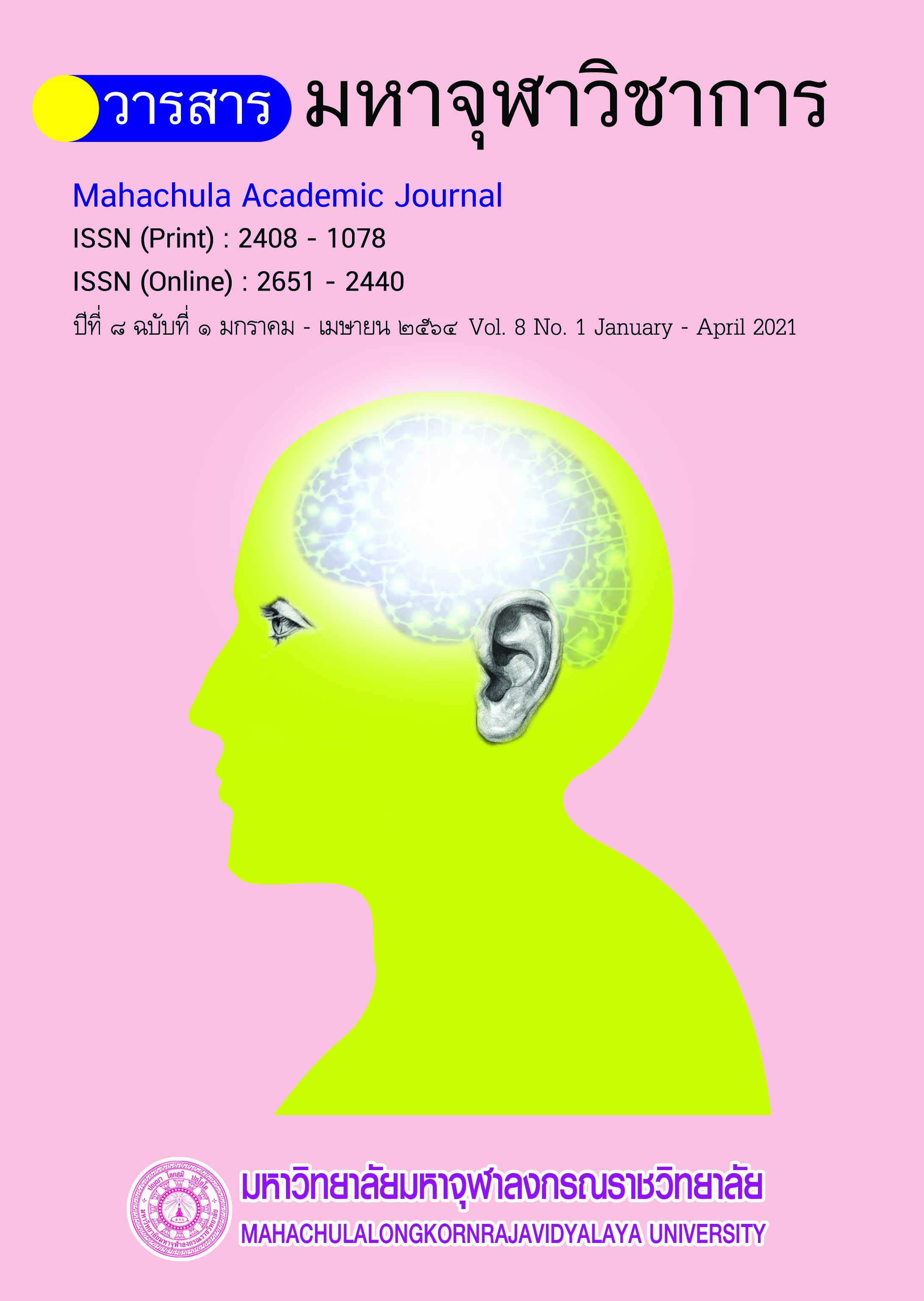Perception of Communication Information for Participating in Activities of the Temple to Inherit Buddhism of Wat Thong Noppakhun in Phetchaburi Province
Main Article Content
Abstract
This research with the objective to: (1) study the community’s perception of communication information for joining the temple activities to inherit Buddhism of Wat Thong Noppakhun, Mueang District, Phetchaburi Province, (2) study relationship between the community’s perception of communication information and participation in the temple activities to inherit Buddhism of Wat Thong Noppakhun, and (3) to create a communication model to build awareness of the community for participation in temple activities to inherit Buddhism of Wat Thong Noppakhun. The samples used in this study were 400 people participating in the activities of Wat Thong Noppakhun, Mueang District, Phetchaburi Province, and 30 people voluntarily participating in focus group discussion. The research instruments were a questionnaire and focus group discussion. The data were analyzed by using frequency, percentage, Chi-square, and content analysis. The research results were as follows: (1) The study of community’s perception of communication information for joining temple activities to inherit Buddhism of Wat Thong Noppakhun, Mueang District, Phetchaburi Province, revealed that most people perceived the information of Wat Thong Noppakhun through public relations via the internet and the amplified loud speakers of the temple, (2) There was relationship with statistical significance at the 0.01level between the community’s perception of the communication information and participation in the temple activities to inherit Buddhism of Thong Noppakhun Temple, Mueang District, Phetchaburi Province, and (3) The communication model to create awareness consisted of 5 important components as follows: (1) The message senders should be the abbot or the monks with many years in monkhood of the temple, (2) The substance of the messages should be activities related to Buddhist practices, (3) Communication channels should be online media together with amplified loud speakers and words of mouth, (4) The message receivers were the group practicing Buddhism activities and the elderly the family members took care of, followed, and took to join the temple's activities, and (5) the reaction and interaction were the heart of the expression of perception. The temple, therefore, considered the participants joining the temple activities much more important. And, during the period of participation in the activities of the temple, the monks, and the novice including the temple committee, had to pay attention to the participants and showed a relationship that impressed them with friendliness as if they were relatives and friends, which this practice always came from the planning with agreement before the practice.
Article Details
References
กันยา สุวรรณแสง. จิตวิทยาทั่วไป. กรุงเทพมหานคร: อักษรพิทยา, ๒๕๕๔.
กาญจนา บุญส่ง และคณะ. “การศึกษาวิถีชีวิตของชุมชนตำบลบางจาก อำเภอเมือง จังหวัดเพชรบุรี”. การประชุมวิชาการนำเสนอผลงานวิจัยศิลปวัฒนธรรมระดับชาติราชภัฏเพชรบุรีวิจัย. ปีที่ ๒ ฉบับที่ ๑ (๒๕๕๘) : ๑๙๔-๒๑๑.
จเรวัฒน์ เทวรัตน์. พฤติกรรมและความต้องการของผู้สมัครเรียนในการเปิดรับสื่อประชาสัมพันธ์ของศูนย์วิทยาพัฒนา มหาวิทยาลัยสุโขทัยธรรมาธิราช นครศรีธรรมราช. นนทบุรี: เอกสารการวิจัย มหาวิทยาลัยสุโขทัยธรรมาธิราช, ๒๕๕๕.
จินตวีร์ เกษมศุข. ประสิทธิผลของการใช้สื่อบุคคลในการประชาสัมพันธ์ เพื่อสร้างภาพลักษณ์ของสถาบันอุดมศึกษาเอกชน. ปทุมธานี: รายงานการวิจัย คณะนิเทศศาสตร์ มหาวิทยาลัยศรีปทุม, ๒๕๕๑.
ธนดล ภูธนะศิริ. “ความประทับใจ ความศรัทธา และการบริจาคของผู้ปฏิบัติธรรมที่วัดแห่งหนึ่งในภาคกลาง”. วารสารเศรษฐศาสตร์การเมืองบูรพา. ปีที่ ๓ ฉบับที่ ๒ (๒๕๕๙) : ๑๓๗-๑๖๒.
ธร สุนทรายุทธ. หลักการและทฤษฎีทางบริหารการศึกษา. ชลบุรี: มหาวิทยาลัยบูรพา, ม.ป.ป.
พระไกรวุฒิ เมืองมา. “ปัจจัยที่ส่งผลต่อการมีส่วนร่วมในกิจกรรมของวัด ตำบลแม่ใส อำเภอเมืองพะเยา จังหวัดพะเยา”. วิทยานิพนธ์ศิลปศาสตรมหาบัณฑิต. สาขาวิชาการบริหารการพัฒนาสังคม: มหาวิทยาลัยพะเยา, ๒๕๖๑.
พระธรรมปิฏก (ป.อ. ปยุตฺโต). พุทธธรรม ฉบับปรับขยาย. พิมพ์ครั้งที่ ๒๖. กรุงเทพมหานคร: ผลิธัมม์, ๒๕๕๕.
พระพรหมคุณาภรณ์ (ป.อ. ปยุตฺโต). พจนานุกรมพุทธศาสตร์ ฉบับประมวลธรรม. พิมพ์ครั้งที่ ๑๓. กรุงเทพมหานคร: เอส. อาร์. พริ้นติ้ง. แมส โปรดักส์, ๒๕๕๖.
พินิจ ลาภธนานนท์. โครงการวิจัยเชิงปฏิบัติการแบบมีส่วนร่วม การเสริมสร้างเครือข่ายพระสงฆ์นักพัฒนาในภาคอีสานเพื่อมีส่วนร่วมในการพัฒนากิจกรรมสร้างเป็นธรรมทางสังคม. กรุงเทพมหานคร: สถาบันวิจัยทางสังคมจุฬาลงกรณ์มหาวิทยาลัย, ๒๕๕๕.
พุทธทาสภิกขุ. ใจความสำคัญแห่งคู่มือมนุษย์. กรุงเทพมหานคร: ภาพพิมพ์, ๒๕๕๓.
ยัง กุนอก. “การศึกษาหลักศรัทธาตามแนวคิดพระพุทธศาสนาเถรวาทของชาวพุทธจังหวัดอุบลราชธานี”. วารสารมนุษยศาสตร์และสังคมศาสตร์. มหาวิทยาลัยราชภัฏอุบลราชธานี. ปีที่ ๗ เล่มที่ ๑ (๒๕๕๙) : ๖๗-๗๖.
วิรัช ภิรัตนกุล. การประชาสัมพันธ์ ฉบับสมบูรณ์ (ปรับปรุงเพิ่มเติมใหม่). พิมพ์ครั้งที่ ๑๒. กรุงเทพมหานคร: สำนักพิมพ์แห่งจุฬาลงกรณ์มหาวิทยาลัย, ๒๕๕๓.
สำราญ จูช่วย. สื่อประชาสัมพันธ์ที่มีผลต่อการตัดสินใจเลือกศึกษาต่อที่วิทยาลัยราชพฤกษ์. เอกสารการวิจัย วิทยาลัยราชพฤกษ์, ๒๕๕๓.
Alderfer, Clayton P. ERG Theory of Motivation Clayton Alderfer’s revision of Abraham Maslow. New York: Harper and Row, 1976.
Cochran, W.G. Sampling Techniques. New York: John Wiley & Sons. Inc., 1953.
Gibson, J. L. and Others. Organizational : Behavior, Structure, Process, Behavior, Dallas. Taxas: Business Publication, Inc., 1973.
เว็บไซต์
มุสลิมจังหวัดเพชรบุรี. ตามรอยมุสลิมเพชรบุรี. [ออนไลน์]. แหล่งที่มา: https://sites.google.com/site/muslimcanghwadphechrburi/2562 [๒๕ ธันวาคม ๒๕๖๒].


